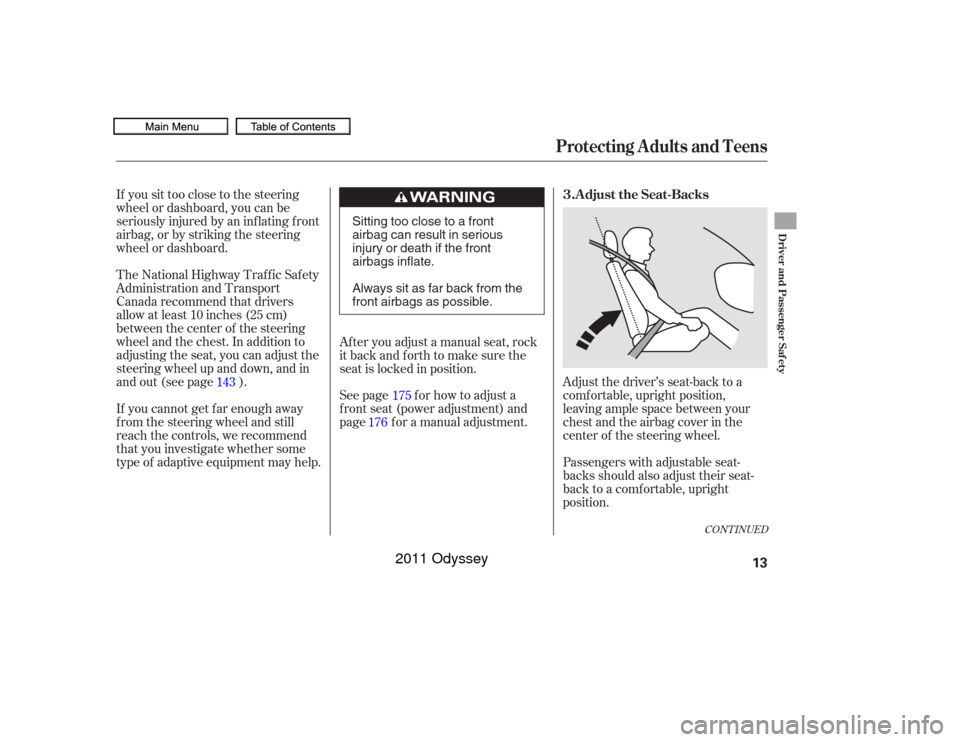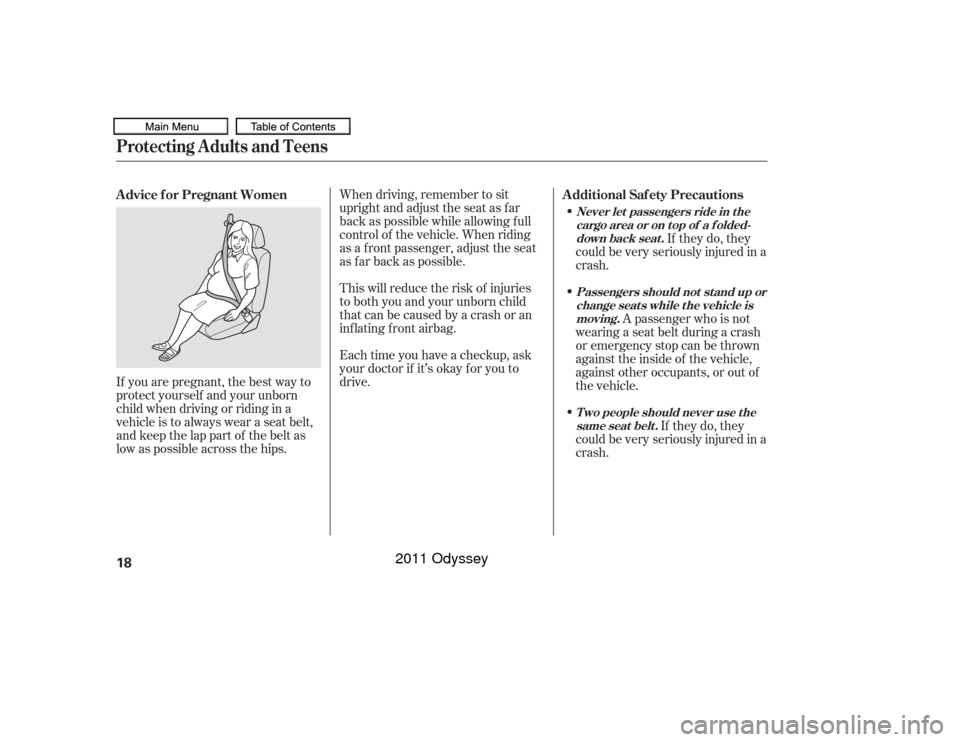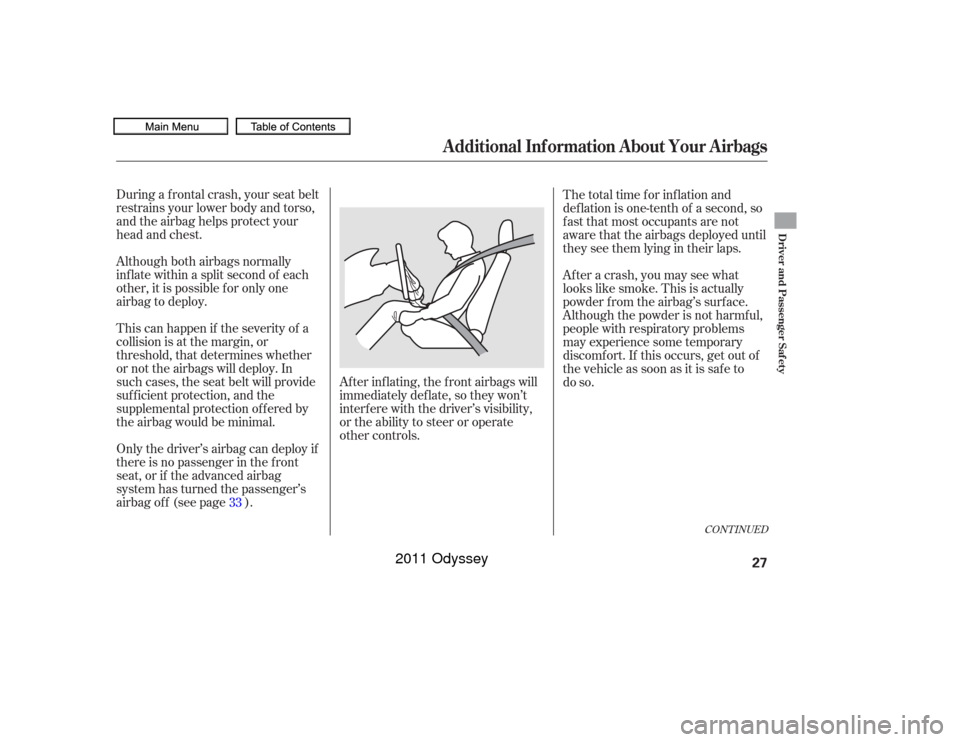Page 16 of 722

If you sit too close to the steering
wheel or dashboard, you can be
seriously injured by an inf lating f ront
airbag, or by striking the steering
wheel or dashboard.Adjust the driver’s seat-back to a
comf ortable, upright position,
leaving ample space between your
chest and the airbag cover in the
center of the steering wheel.
Passengers with adjustable seat-
backs should also adjust their seat-
back to a comf ortable, upright
position.
The National Highway Traffic Safety
Administration and Transport
Canada recommend that drivers
allow at least 10 inches (25 cm)
between the center of the steering
wheel and the chest. In addition to
adjusting the seat, you can adjust the
steering wheel up and down, and in
and out (see page ).
After you adjust a manual seat, rock
it back and forth to make sure the
seat is locked in position.
See page f or how to adjust a
f ront seat (power adjustment) and
page f or a manual adjustment.
If you cannot get f ar enough away
f rom the steering wheel and still
reach the controls, we recommend
that you investigate whether some
type of adaptive equipment may help. 143
175
176
CONT INUED
Adjust the Seat-Backs
3.
Protecting A dults and Teens
Driver and Passenger Saf ety
13
Sitting too close to a front
airbag can result in serious
injury or death if the front
airbags inflate.
Always sit as far back from the
front airbags as possible.
10/07/17 09:36:01 31TK8600_018
2011 Odyssey
Page 21 of 722

If you are pregnant, the best way to
protect yourself and your unborn
child when driving or riding in a
vehicle is to always wear a seat belt,
and keep the lap part of the belt as
low as possible across the hips.When driving, remember to sit
upright and adjust the seat as f ar
back as possible while allowing f ull
control of the vehicle. When riding
as a f ront passenger, adjust the seat
as far back as possible.
This will reduce the risk of injuries
to both you and your unborn child
that can be caused by a crash or an
inflating front airbag.
Each time you have a checkup, ask
your doctor if it’s okay f or you to
drive.
If they do, they
could be very seriously injured in a
crash.
A passenger who is not
wearing a seat belt during a crash
or emergency stop can be thrown
against the inside of the vehicle,
against other occupants, or out of
the vehicle.
If they do, they
could be very seriously injured in a
crash.
Advice f or Pregnant Women
Additional Saf ety Precautions
Never let passengers ride in t he
cargo area or on t op of a f olded-down back seat .
Passengers should not stand up orchange seats while the vehicle ismoving.
T wo people should never use t hesame seat belt .
Protecting A dults and Teens18
10/07/17 09:36:37 31TK8600_023
2011 Odyssey
Page 27 of 722
A irbag System ComponentsAdditional Inf ormation About Your Airbags24
(9)
(15) (6)
(1)
(4)(11) (11)
(14) (4)
(5)
(12)
(13)
(8)
(4)
(5)
(3)
(11)
(7) (10)
(2)
(6) Side Curtain Airbags
(7) Driver’s Seat Position Sensor
(8) Front Passenger’s Weight Sensors
(9) Front Impact Sensors
(10) Passenger Airbag Off Indicator (1) Driver’s Front Airbag
(2) Passenger’s Front Airbag
(3) Control Unit/Rollover Sensor
(4) Front Seat Belt Tensioners
(5) Side Airbags
(14) Rear Safing Sensor
(15) Supplemental Restraint System (SRS) Indicator (11) Side Impact Sensors
(12) Occupant Position Detection System (OPDS) Sensors
(13) Front Passenger’s Weight Sensors Control Unit/ OPDS Sensors Control Unit
10/07/17 09:37:19 31TK8600_029
2011 Odyssey
Page 28 of 722

Your airbag system includes:Two SRS (supplemental restraint
system) f ront airbags. The driver’s
airbag is stored in the center of
the steering wheel; the f ront
passenger’sairbagisstoredinthe
dashboard. Both are marked ‘‘SRS
AIRBAG’’ (see page ).
Two side airbags, one f or the
driver and one f or a f ront
passenger. The airbags are stored
in the outer edges of the seat-
backs. Both are marked ‘‘SIDE
AIRBAG’’ (see page ). Two side curtain airbags, one f or
each side of the vehicle. The
airbags are stored in the ceiling,
above the side windows. The f ront
and rear pillars are marked ‘‘SIDE
CURTAIN AIRBAG’’ (see page
).Sensors that can detect whether
the driver’s seat belt and the f ront
passenger’s seat belt are latched
or unlatched (see page ).
A driver’s seat position sensor that
monitors the distance of the seat
from the front airbag. If the seat is
too f ar f orward, the airbag will
inflate with less force (see page
).
Weight sensors that monitor the
weight on the f ront passenger’s
seat. If the weight is about 65 lbs
(29 kg) or less (the weight of an
inf ant or small child), the
passenger’s f ront airbag will be
turned of f (see page ).
Automatic front seat belt
tensioners (see page ).
Sensors that can detect a
moderate to severe front impact,
side impact, or if your vehicle is
about to rollover.
Sensors that can detect whether a
child is in the passenger’s side
airbag path and signal the control
unit to turn the airbag of f (see
page ).
26
30 31
22
31 20
29
29
CONT INUED
Additional Inf ormation About Your Airbags
Driver and Passenger Saf ety
25
10/07/17 09:37:28 31TK8600_030
2011 Odyssey
Page 29 of 722

If you ever have a moderate to
severe f rontal collision, sensors will
detect the vehicle’s rapid
deceleration.
If the rate of deceleration is high
enough, the control unit will inf late
the driver’s and f ront passenger’s
airbags, at the time and with the
f orce needed.
An indicator on the instrument
panel that alerts you that the
passenger’s side airbag has been
turned of f (see page ).
An indicator on the dashboard that
alerts you that the passenger’s
f ront airbag has been turned of f
(see page ).
Emergency backup power in case
your vehicle’s electrical system is
disconnected in a crash.
A rollover sensor that can detect if
your vehicle is about to roll over
and signal the control unit to
deploy both side curtain airbags
(see page ).
A sophisticated electronic system
that continually monitors and
records inf ormation about the
sensors, the control unit, the
airbag activators, the seat belt
tensioners, and driver and f ront
passenger seat belt use when the
ignition switch is in the ON (II)
position.
An indicator on the instrument
panel that alerts you to a possible
problem with your airbag system
components (see page ). 32
32 33
33 How Your Front Airbags Work
Additional Inf ormation About Your Airbags26
10/07/17 09:37:36 31TK8600_031
2011 Odyssey
Page 30 of 722

During a f rontal crash, your seat belt
restrains your lower body and torso,
and the airbag helps protect your
head and chest.
Although both airbags normally
inf late within a split second of each
other, it is possible f or only one
airbag to deploy.
This can happen if the severity of a
collision is at the margin, or
threshold, that determines whether
or not the airbags will deploy. In
such cases, the seat belt will provide
suf f icient protection, and the
supplemental protection of f ered by
the airbag would be minimal.
Only the driver’s airbag can deploy if
there is no passenger in the f ront
seat, or if the advanced airbag
system has turned the passenger’s
airbag off (see page ).Af ter inf lating, the f ront airbags will
immediately def late, so they won’t
interf ere with the driver’s visibility,
or the ability to steer or operate
other controls. The total time for inflation and
def lation is one-tenth of a second, so
f ast that most occupants are not
aware that the airbags deployed until
they see them lying in their laps.
After a crash, you may see what
looks like smoke. This is actually
powder f rom the airbag’s surf ace.
Although the powder is not harmf ul,
people with respiratory problems
mayexperiencesometemporary
discomf ort. If this occurs, get out of
the vehicle as soon as it is saf e to
33
CONT INUED
Additional Inf ormation About Your Airbags
Driver and Passenger Saf ety
27
10/07/17 09:37:44 31TK8600_032
do so.
2011 Odyssey
Page 33 of 722

A second row passenger pushing
or pulling on the back of the f ront
passenger’s seat.
Moving the f ront seat f orcibly
back against cargo on the seat, the
f loor behind it, or a f olded second
row seat.
Hanging heavy items on the f ront
passenger seat, or placing heavy
items in the seat-back pocket.
Second-row passengers should not
wedge objects or intentionally
f orce their f eet under the f ront
passenger seat.
Also,makesurethefloormatbehind
the f ront passenger’s seat is properly
positioned on the f loor (see page ). If it is not, the mat may
interf ere with the proper operation
of the f ront passenger’s seat and its
sensors. If you ever have a moderate to
severe side impact, sensors will
detect rapid acceleration and signal
the control unit to instantly inf late
either the driver’s or the passenger’s
side airbag. Only one airbag will deploy during a
side impact. If the impact is on the
passenger’s side, the passenger’s
side airbag will deploy even if there
is no passenger.
To get the best protection f rom the
side airbags, front seat occupants
should wear their seat belts and sit
upright and well back in their seats.
637
Additional Inf ormation About Your Airbags
How Your Side A irbags Work
30
10/07/17 09:38:07 31TK8600_035
2011 Odyssey
Page 34 of 722

CONT INUED
Your vehicle has a side airbag cutof f
system designed primarily to protect
a child riding in the f ront passenger’s
seat.
Although Honda does not encourage
children to ride in f ront, if the
position sensors detect a child has
leaned into the side airbag’s
deployment path, the airbag will
Thesideairbagmayalsoshutoff if a
short adult leans sideways, or a
larger adult slouches and leans
sideways into the airbag’s
deployment path.
Objects placed on the f ront
passenger seat can also cause the
side airbag to be shut of f .If the side airbag of f indicator comes
on (see page ), have the
passenger sit upright. Once the
passenger is out of the airbag’s
deployment path, the system will
turn the airbag back on, and the
indicator will go out.
There will be some delay between
the moment the passenger moves
into or out of the airbag deployment
pathandwhentheindicatorcomes
on or goes of f .
A f ront seat passenger should not
use a cushion or another object as a
backrest. It may prevent the cutof f
system f rom working properly.
In a moderate to severe side impact,
sensors will detect rapid acceleration
and signal the control unit to
instantly inflate the side curtain
airbag.
33
Additional Inf ormation About Your Airbags
Side A irbag Cut of f Syst em
In a Side Impact
How Your Side Curtain A irbags
Work
Driver and Passenger Saf ety
31
SIDE CURTAIN AIRBAG
10/07/17 09:38:17 31TK8600_036
shut off.
2011 Odyssey